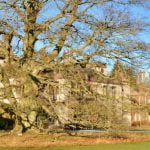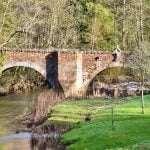Although no longer surviving as an upstanding earthwork, the cropmark evidence, together with the results of limited excavations and survey, confirm that this is a complete, well-preserved and exceptionally large Roman fort, built during the first attempt by the Romans to conquer Caledonia in the AD 80s.
The fort measures approximately 207m NW-SE by 179m transversely, enclosing an area of about 3.7ha, making it one of the largest Roman forts in Britain. A defensive system of one turf-built bank, 6.1m wide, and four substantial ditches, between 5-15m wide and 1.5-3m deep, defines its perimeter. A series of buildings and thoroughfares are clearly visible in the interior. Limited excavations between 1966-1975 revealed the presence of rows of timber barracks, a large granary and cobbled streets.
Cardean was one part of a line of forts and watchtowers (called the Gask Ridge) stretching from Drumquhasssle near Loch Lomond to Stracathro near Brechin, centred on the legionary fortress of Inchtuthil near Dunkeld.
These forts, which were built by troops under the command of the Roman Gnaeus Julius Agricola, were intended as a frontier from which the invading army hoped to pacify the local tribes.
Although the Romans went on to reach the shores of Moray Firth, well to the north, they later retreated south to create new frontiers marked by Hadrian’s Wall built in AD 122 and the Antonine Wall built in AD 142.
The fort was partially excavated between 1966-1975, initially under James Robinson (to 1967) and latterly by the Scottish Field School of Archaeology, directed by Dr A. S. Robertson.
Sources:
Canmore
Heritage Environment Scotland
Christopher Dingwall



